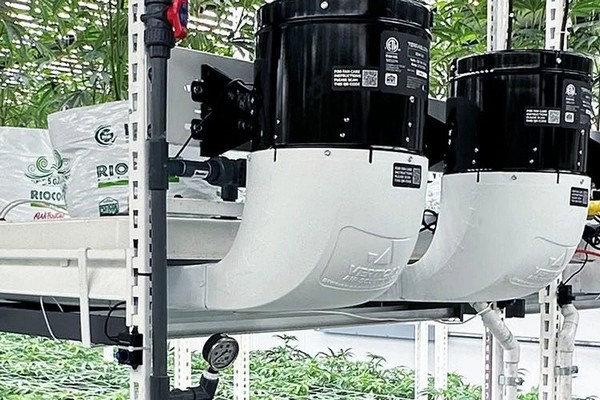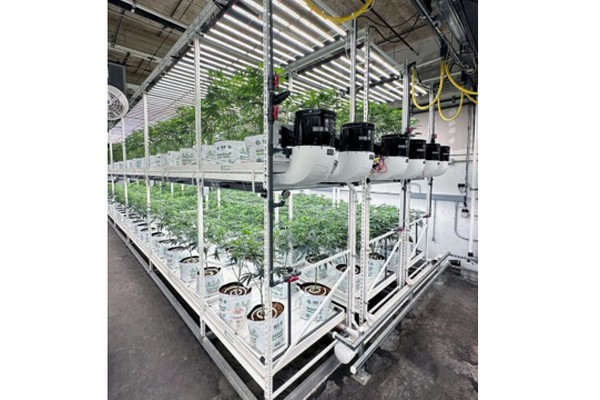"As Pipp Horticulture's Director of Horticulture, one of the most common issues I help cannabis growers and controlled environment agriculture (CEA) producers with is improving airflow within the crop canopy," says Anders Peterson. "Interestingly, several of those conversations follow this script:"
Grower: "I'm not getting enough airflow."
Anders: "Ok, what airflow do you want to get?"
Grower: "Well, I want to see my leaves dancing."
Anders: "But what does that mean? Leaf dancing is not a quantification."
Anders explains that despite how sophisticated indoor farming has become over the last decade, with many sensor and control system companies investing heavily in data collection and analysis tools, most growers still rely on subjective visual cues to determine whether enough air is flowing through their plant canopies. "Even if these groups have an interest in quantifying this cultivation parameter, many control systems aren't set up to do so, as they are often designed for outdoor farms or greenhouses where air speed is out of the grower's control. Instead, most controllers prioritize parameters such as air and soil temperature, light, humidity, CO2 concentration, water, and nutrients."

Even with the right control systems, CEA growers can encounter limitations with the airflow sensors themselves. "Many commercially available airflow sensors are designed to measure outside wind speeds for greenhouses and outdoor farms. As such, most are not sensitive enough to get an accurate reading of indoor airflow speed targets. Airflow sensors for indoor farms should be able to accurately measure airflow coming from all directions in the targeted velocity ranges."
"As a scientist and data-driven cultivator, I've spent the last several months studying airflow," Anders says. "During this time, I've developed a deep appreciation for quantifying airflow in plant growth environments. Like most things in CEA, measuring airflow requires a decent understanding of the available tools (and their limitations), as well as the time and desire to collect and analyze data over months. By moving from subjective assessments, like the level of perceived leaf dancing, to precise measurements, growers can maximize the expression of their crop's genetic potential, grow healthier plants, and increase their bottom line."
Use the right metric: Airflow, not flow rate
Measuring airflow requires growers to determine the speed at which air is moving through or across their plant canopies. "For the airspeeds we are targeting in indoor cultivation, the most appropriate units of measurement to use are meters per second (m/s) or feet per minute (ft/min). (Miles or kilometers per hour (mph/kph) are better metrics for measuring much higher airspeeds, such as those found outdoors)"
Airflow velocity can (and should) be measured across multiple points in a cultivation environment, Anders says. "For example, growers may be interested in knowing the air velocity coming out of a ventilation duct or fan as well as closer to the canopy top, or even within the canopy, to understand how equipment layout influences how air moves through the space. While air speeds may be adequate near ventilation equipment, vertical racks, plant density, and other factors can impede that flow where it is most needed."
According to Anders, it is important to avoid conflating airflow, a velocity measure, and volumetric flow rates, measured in cubic feet per minute (CFM). "CFM is commonly used for measuring the capacity, or flow rate, of fans, blowers, and HVAC systems, along with the flow rates through ductwork. This figure can help growers determine the system requirements needed to achieve their desired amount of air changes in a given period. CFM can be calculated by multiplying the velocity of the air (in feet per minute) within a defined area."
"Unless growers are measuring within a defined space, like in a piece of ductwork, growers should always be using feet per minute or meters per second when discussing airflow. Various academic sources cite a target airflow speed of between 0.5-1 m/s (~100-200 feet per minute) at the canopy top for most crops. For leafy greens, growers can target the lower end of the range, while tomato crops can be pushed to the upper range."
Due to the generally high light levels and transpiration rates, cannabis plants may require even greater airflow speeds to maintain optimal plant growth. "Anecdotally, targeting 1.25 – 1.5 m/s (~250-300 ft/min) at light levels between 1,000-1,200 PPFD will better homogenize the leaf surface temperature, facilitate gas exchange, and prevent moist air from stagnating. In vegetative growth, speeds of 0.5-1 m/s generally are sufficient. Essentially, the higher the light levels on your crop, the more airflow is needed to balance the energy transfer within the plant and within the grow room."
How to measure airflow in indoor farms
While there are limited tools specifically designed to measure airflow in CEA environments, technologies from other industries and use cases can be used as we wait for better purpose-built solutions.
Infrared (IR) thermometers
Indoor farmers and greenhouse operators may already be using infrared (IR) thermometers to monitor their crops leaf surface temperature for VPD calculations. These heat-sensing devices can be used to get an indirect airflow measurement by detecting differences in leaf surface temperatures across the plant canopy in a given grow room. Areas of the canopy with higher leaf surface temperatures than the rest of the room can indicate a lack of sufficient airflow in those zones.
IR thermometers can provide qualitative information about airflow patterns and speeds within a space but do not offer precise airflow readings needed to optimize growing environments. Nevertheless, this data is better than making decisions based on human senses or dancing leaves.
Cup/vane anemometers
Cup or vane anemometers use a mechanical system to measure airflow. Cups or fan blades pushed by wind spin on an axis, and the number of revolutions per minute determines the wind speed. These systems are common in outdoor farms and can be affixed to the top of greenhouses to capture outside wind speed.
While handheld models exist, cup or vane anemometers are generally not sensitive enough to measure the lower air velocities we are targeting in indoor cultivation. Furthermore, these handheld devices only provide accurate readings when held vertically and are not useful when measuring top-down or bottom-up airflow in vertical farms.
Hot-wire anemometers
Hot-wire anemometers are handheld devices generally used in the HVAC industry to measure in-duct airflow. A small wire sticks out of one end of the device. That wire gets heated and cools off as air moves around it. The voltage required to heat it back up to setpoint is correlated to the amount of air velocity going across it. These are currently some of the best handheld devices that growers can use to measure intracanopy airflow.
Unidirectional hot-wire anemometers are more readily available and come at a lower price point, but require the user to point the device in the correct direction and can only take airflow readings from one direction at a time. (These units will have an arrow indicating how the user can align the wire against the airflow direction.)
However, airflow is hardly ever coming from one direction in cultivation environments and is instead quite turbulent. Also, in multi-tier grow rooms, cultivators often use a combination of side, bottom-up, and/or top-down airflow systems (like Pipp's In-Rack Airflow Systems) and can find it difficult to get an accurate airflow reading using unidirectional hot-wire anemometers. Despite coming in at a higher price point and having fewer options available on the market, omnidirectional hot-wire anemometers can measure airflow coming from multiple directions. This makes them ideal tools to measure canopy-level airflow in indoor farms and greenhouse environments.
When using either unidirectional or omnidirectional anemometers, operators must take multiple measurements across the top of their plant canopies. By taking measurements at various points in their cultivation areas, growers can map out where the dead zones are and begin to optimize their airflow maps by adjusting fan positioning and intensities. By averaging these multiple readings, growers can determine the room's plant canopy airflow velocity. This metric can be correlated with other cultivation parameters within the automation and control systems to optimize their cultivation strategies.
Airflow sensors
Growers whose automation and control systems can measure and data log airflow can install air velocity sensors within and around their plant canopies to get a true understanding of how air moves through their crop.
Airflow sensors require some labor to install and commission but offer the most in-depth insights into intracanopy air movement. Similarly to measuring air velocity with handheld hot-wire anemometers, it is important to place sensors in different locations in cultivation rooms to get a better sense of the room's airflow, including at different heights within the canopy and across all grow tiers.
Key takeaway
"By moving beyond subjective readings like leaf-dancing that leave a lot of room for interpretation and adopting strong quantitative data collection and analysis practices, growers can not only build optimized, resource-efficient facilities but can also gain peace of mind that they are doing everything they can to grow healthy, productive crops," Anders concludes.
For more information:
Pipp Horticulture
Email: [email protected]
[email protected]
www.pipphorticulture.com
